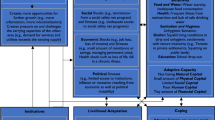Abstract
This analysis examines new governance tools that can be applied to security issues among the aging population in the United States, particularly in Central Florida. The authors explain the problem about the structure of law enforcement agencies today. Traditional bureaucratic organizations have a hierarchical and centrally structured system, which operates with strict rules and regulations. The authors proceed to compare two models of governance: the traditional bureaucratic government and the new model governance. The latter is better in that it uses indirect methods and innovative tools. These tools are (1) grants, (2) needs assessments, (3) senior volunteers, (4) co-production, and (5) citizen participation.





Similar content being viewed by others
References
Agranoff, R. (2003). Leveraging networks: A guide for public managers working across organizations. Washington, DC: IBM Center for the Business of Government.
American Academy of Anti-Aging Medicine (2002). Official position statement on the truth about human aging. Available from: http://www.worldhealth.net/pages/official_position_statement_on_the_truth. (accessed 11/2/2008).
Arnstein, S. R. (1969). A ladder of citizen participation. Journal of the American Planning Association, 35(4), 216–224.
Beam, D. R., & Conlan, T. J. (2002). Grants. In L. Salamon (Ed.), The tools of government: A guide to the new governance (pp. 340–380). New York: Oxford University Press.
Breen, G. M., & Matusitz, J. (2007). An interpersonal examination of telemedicine: applying relevant communication theories. eHealth International Journal, 3(1), 18–23.
Breen, G. M., & Matusitz, J. (2010). An evolutionary examination of telemedicine: a health and computer-mediated communication perspective. Social Work in Public Health, 25(1), 59–71.
Breen, G. M., & Zhang, N. J. (2008). Introducing ehealth to nursing homes: theoretical analysis of improving resident care. Journal of Medical Systems, 32(2), 187–192.
Breen, G. M., Matusitz, J., & Sousa, A. (2008). Cyberterrorism in telemedicine: a new threat to computer-mediated communication systems. eHealth International Journal, 4(2), 14–19.
Breen, G. M., Wan, T. T. H., & Ortiz, J. (2010). Information technology adoption in rural health clinics: a theoretical analysis. Journal of Information Technology Impact, 10(1), 10–21.
Cheney, G., Christensen, L. T., Zorn, T. E., Jr., & Ganesh, S. (2010). Organizational communication in an age of globalization: Issues, reflections, practices. Prospect Heights: Waveland Press Inc.
Community Oriented Policing Services (COPS) (2006). COPS Interoperable Communications Technology Program Fact Sheet. Washington, DC: U.S. DJO of COPS.
Cooper, T. L. (2004). Big questions in administrative ethics: a need for focused, collaborative effort. Public Administration Review, 64(4), 395–407.
Cooper, T., Bryer, T., & Meek, J. (2006). Citizen-centered collaborative public management. Public Administrative Review, 66(1), 76–86.
DiMaggio, P., & Powell, W. (1983). The iron cage revisited: institutional isomorphism and collective rationality in organizational fields. American Sociological Review, 48(2), 147–160.
Fung, A. (2006). Varieties of participation in complex governance. Public Administration Review, 66(1), 66–75.
Gazley, B., & Brudney, J. (2005). Volunteer involvement in local government after September 11: the continuing question of capacity. Public Administration Review, 65(2), 131–142.
Goldsmith, S., & Eggers, W. (2004). Government by network: The new shape of the public sector. Cambridge: Ash Institute, Harvard University & Deloitte Research.
Harvard School of Public Health (2003). Reinventing aging baby boomers and civic engagement. Cambridge: Harvard School of Public Health-MetLife Foundation Initiative on Retirement and Civic Engagement.
Irvin, R. A., & Stansbury, J. (2004). Citizen participation in decision making: is it worth the effort? Public Administration Review, 64(1), 55–65.
Jackson, M. O. (2008). Social and economic networks. Princeton: Princeton University Press.
Kamarc, E. (2002). Applying 21st-century government to the challenge of homeland security. Washington, DC: IBM Center for the Business of Government.
Kettl, D. F. (2000). The global public management revolution: A report on the transformation of governance. Washington, DC: Brookings Institution.
Kettner, P., Moroney, R., & Martin, L. (2008). Designing and managing programs. Thousand Oaks: Sage.
Klitgaard, R., & Treverton, G. (2003). Assessing partnerships: New forms of collaboration. Washington, DC: IBM Center for the Business of Government.
Knickman, J., & Snell, E. (2002). The 2030 problem: caring for aging baby boomers. Health Services Research, 37(4), 849–884.
Kohlbacher, F., & Hang, C. (2007). Disruptive innovations and the greying market. Paper presented at Industrial Engineering and Engineering Management International Conference, Tokyo: German Inst. for Japanese Studies, 1915–1919.
Koschmann, M. (2009). Communication in collaborative interorganizational relationships: An empirical study of leadership and stakeholder participation in the community action network. Saarbrücken: VDM Verlag.
Kurlander, N. (2006). Out of step—NIEM and N-DEx; Two national data-sharing initiatives face major challenges. Available from: http://xml.sys-con.com/node/175403. (accessed 11/5/2008).
Lukensmeyer, C. J., & Brigham, S. (2005). Taking democracy to scale: large scale interventions for citizens. The Journal of Applied Behavioral Science, 41(1), 47–61.
Lukensmeyer, C., & Torres, L. (2006). Public deliberation: A manager’s guide to citizen engagement. Washington, DC: IBM Center for the Business for Government.
Mann, R. M., Senn, C. Y., Girard, A., & Ackbar, S. (2007). Community-based interventions for at-risk youth in Ontario under Canada’s Youth Criminal Justice Act: a case study of a runaway girl. Canadian Journal of Criminology and Criminal Justice, 49(1), 37–77.
Martin, L. L. (2006). Privatization: Looking backward, looking forward. Annual Privatization Report, Los Angeles: The Reasons Foundation, pp. 42–44.
Martin, S., Yen, D. C., & Tan, J. K. (2002). E-health: impacts of Internet technologies on various healthcare and services sectors. International Journal of Healthcare Technology and Management, 4(2), 71–86.
Maslow, A. H. (1954). Motivation and personality. New York: Harper & Brothers.
Matusitz, J., & Breen, G. M. (2007a). E-health: a new kind of telemedicine. Social Work in Public Health, 23(1), 95–113.
Matusitz, J., & Breen, G. M. (2007b). Telemedicine: its effects on health communication. Health Communication, 21(1), 73–83.
Matusitz, J., Breen, G. M., Marathe, S. S., & Wan, T. T. H. (2010). Nurses in need of additional support: web sites offering information in nursing environments. Creative Nursing, 16(3), 115–118.
McGuire, M. (2002). Managing networks: propositions on what managers do and why they do it. Public Administration Review, 62(5), 599–609.
Milward, H., & Provan, K. G. (2006). A manager’s guide to choosing and using collaborative networks. Washington, DC: IBM Center for the Business of Government.
Moynihan, D. P. (2008). Combining structural forms in the search for policy tools: incident command systems in U.S. crisis management governance. An International Journal of Policy, Administration, and Institutions, 21(2), 205–229.
National Crime Victimization Survey (NCVS) (2004). National Crime Victimization Survey. Washington, DC: U.S. Department of Justice.
Netting, F. E., O’Connor, M. K., & Fauri, D. P. (2008). Comparative approaches to program planning. New York: Wiley.
Nooteboom, B. (2009). A cognitive theory of the firm: Learning, governance and dynamic capabilities. Northampton: Edward Elgar.
Pestoff, V. (2006). Citizens and co-production of welfare services; childcare in eight European countries. Public Management Review, 8(4), 503–519.
Ponsioen, J. A. (1962). The analysis of social change reconsidered: A sociological study. The Hague: Mouton.
Provan, K. G., & Milward, H. B. (1995). A preliminary theory of interorganizational network effectiveness: A comparative study of four community mental health systems. Administrative Science Quarterly, 40(1), 1–33.
Ravenna, D. (2006). Seniors vs. crime: History. Available from: http://www.seniorsvscrime.com/history.htm. (accessed 11/11/2008).
Reddel, T. (2002). Beyond participation, hierarchies, management & markets: new governance & place policies. Australian Journal of Public Administration, 61, 50–63.
Salamon, L. (2002). The tools of government a guide to the new governance. New York: Oxford University Press.
Silverman, M. G. (2008). Compliance management for public, private, or non-profit organizations. Boston: McGraw-Hill.
Simo, G., & Bies, A. (2007). The role of nonprofits in disaster response: an expanded model of cross-sector collaboration. Public Administration Review, 67(1), 125–142.
State of Florida (2005). Florida population age distribution by percentage. Available from: http://www.preconstructionprograms.com/real_estate/florida/florida_real_estate_report_wachovia_2.php. (accessed 11/2/2008).
St. John, E. (2009). College organization and professional development: integrating moral reasoning and reflective practice. New York: Routledge.
Terpstra, J. (2004). Police, local government and citizens as participants in local safety networks. Available from: http://www.ncjrs.gov/pdffiles1/nij/Mesko/207978.pdf. (accessed 11/15/2008).
TRIAD Council (2003). Orange County TRIAD and S.A.L.T. Council. Orlando: Orange County Sheriff Office.
Vogel, M. (2006). High population growth rate in Florida. Available from: http://www.preconstructionprograms.com/real_estate/florida/florida_growth_trend.php. (accessed 11/3/2008).
Wan, T. T. H., Breen, G. M., Zhang, N. J., & Unruh, L. (2010). An evidence-based approach to improving the quality of care in nursing homes. Baltimore: Johns Hopkins University Press.
White House (2006). State of the Union Address by the President. Available from: http://www.whitehouse.gov/stateoftheunion/2006/. (accessed 10/22/2008).
Yin, P. P. (1980). Fear of crime among the elderly: some issues and suggestions. Journal of the University of California Press, 27(4), 492–504.
Zhao, J., He, N., & Nicholas, L. P. (2003). Community policing: did it change the basic functions of policing in the 1990s? A national follow-up study. Justice Quarterly, 20(4), 697–724.
Author information
Authors and Affiliations
Corresponding author
Rights and permissions
About this article
Cite this article
Uryan, Y., Matusitz, J. & Breen, GM. Improving Quality of Life for Seniors: New Governance Tools. Ageing Int 37, 318–337 (2012). https://doi.org/10.1007/s12126-010-9080-1
Published:
Issue Date:
DOI: https://doi.org/10.1007/s12126-010-9080-1




